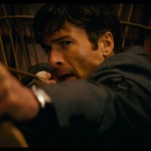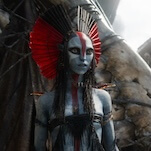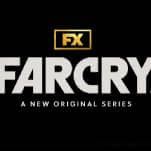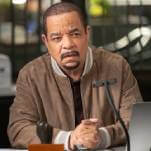Each week, Big Issues focuses on a newly released comic-book issue of significance. This week, it’s The Flintstones #6. Written by Mark Russell (Prez, Apocrypha Now) with art by Steve Pugh (Animal Man, All-New Invaders) and colorist Chris Chuckry (The Unwritten, Vote Loki), this issue uses the threat of imminent extinction to continue the series’ biting critique of modern American society. (This review reveals major plot points.)
Who’d have thought that The Flintstones would be one of the smartest comics currently being published? Simultaneously goofy, clever, insightful, and emotional, it’s easily the strongest title of DC Comics’ Hanna-Barbera revival, building on the original cartoon concept in fascinating ways that are consistently surprising. Of the new Hanna-Barbera comics—which also include Scooby Apocalypse, Wacky Raceland, and Future Quest—The Flintstones does the best work channeling the spirit of its source material with a more modern storytelling sensibility. Writer Mark Russell, artist Steve Pugh, and colorist Chris Chuckry are using the town of Bedrock and its inhabitants to offer sharp social and political commentary wrapped in imagination and humor.
This week’s The Flintstones #6 has the town of Bedrock in a panic over an approaching asteroid, and the creative team uses this end-of-the-world scenario to explore how the threat of imminent death brings out the worst in people. Social systems break down when Professor Sargon (modeled after Carl Sagan) calculates that an asteroid is on a collision course with Earth: Violence erupts at the First Church Of Gerald, police officers abandon their duties, and the Bedrock Mall is plunged into chaos as capitalism crumbles. The comic’s creators approach Bedrock as a prehistoric mirror of modern American society, and it’s not hard to find present-day connections in a story that begins with the city announcing its elitism before devolving into a primitive free-for-all when the lives of its citizens are put in danger.
The United States is currently embroiled in intense political turmoil that makes the future of the nation increasingly unstable, and to make matters even grimmer, the National Center For Health Statistics revealed this week that life expectancy in the country dropped for the first time in 22 years. Global warming continues to ravage the planet, and international tensions are rising, putting the entire world at risk. 2016 has been a scary year, and as Yoda says, fear leads to anger, hatred, and ultimately suffering. There’s been a significant rise in hate crimes in the U.S. following the election of Donald Trump as president, and while the circumstances behind the violence in this week’s The Flintstones are considerably different, these destructive actions are all rooted in a fear of larger issues, which is misdirected toward individuals who don’t have any direct influence on these problems. These real-world parallels aren’t made explicit in Russell’s script, but the nature of this book encourages readers to search for those connections.
Each issue of The Flintstones tells a self-contained story, so new readers can jump in at any point, just like episodes of the cartoon. Another similarity is the prevalence of puns and visual gags; this week’s issue opens with a splash page of the Bedrock Mall, which features establishments like Spears And Roebuck, Panda Excess, and Foot Licker Restaurant. The Outback Snakehouse makes an appearance later, Professor Sargon keeps his moths in his “mothadone clinic,” and a member of the First Church Of Gerald performs a “preach-around” when he proselytizes to his priest. Some of these puns are groan-worthy, but there’s something appealing about this basic humor, especially as a contrast to the more serious elements of the series.
Russell has expanded the focus beyond the Flintstone and Rubble families, with the most powerful moments of this week’s issue involving Fred’s boss and the animals being used as appliances, tools, and playthings. Mr. Slate has devoted most of his life to his business, and now that he’s facing the end of his life, he wants to spend his remaining days with family and friends. Unfortunately, he doesn’t have either, and when he opens up his home to his employees, they unanimously decline the invitation. Sitting by himself in his mansion, drinking a pink squirrel (the cocktail, not a literal animal), Mr. Slate reveals to his pet turtle that he’s afraid of dying alone and fading from the memory of everyone who might have loved him. He stares out at the sign for Slate’s Quarry and wonders if it will survive the asteroid. The quiet melancholy of this scene adds a layer of tragedy to Mr. Slate that makes him a more complex character.
The decision to explore the lives of Bedrock’s animal workforce provides a compelling new perspective of this world, and the conversation between the Flintstones’ elephant vacuum and Fred’s armadillo bowling ball is adorable, hilarious, and heartwarming. The armadillo echoes its owner’s complaints about a brutal workday as it recounts the mysterious act of being rolled across the floor into a dark tunnel, where it’s convinced it will die; like Mr. Slate, the armadillo is unsatisfied with its place in the universe. The elephant, who spends its days trapped in a closet when it’s not being used, offers some solace to the armadillo by saying that their friendship is what keeps him going. The scene ends with a message that applies to the entire issue: “Maybe the only meaning to life is that which we get from each other.”
This struggle is amplified by the emotion Pugh brings to the animals’ characters. The range and specificity of the expressions in his artwork are essential to realizing both the humor and drama of Russell’s scripts. Even when Mr. Slate is extending a friendly invitation, his face and body project a stern severity that is off-putting to his employees, and the changes in the general mood of Bedrock are reflected in how characters carry themselves. Everyone is confident and comfortable at the start, but the expressions become more aggressive as terror takes hold, eventually giving way to confusion and shame when it’s revealed that Professor Sargon’s prediction of doom was incorrect.
Bill Sienkiewicz’s cover for this issue does excellent work capturing the book’s distinct aesthetic. There’s an element of cartoonish exaggeration in Sienkiewicz’s linework, particularly for the dinosaurs in the background, but the scratchy inks and textured colors add grit. The coloring makes it look like he could have painted this image on the walls of a cave, creating an earthiness that contrasts with the more heightened aspects of the cover, a visual dynamic that can also be found in Pugh’s and Chuckry’s artwork within.
The designs of Pugh’s artwork are firmly based in the style of the cartoon, but his rendering is far more realistic, bringing a stronger sense of weight to this world and its characters. Chuckry’s coloring adds considerable texture to the environments and the wildlife, but he uses flatter colors for the characters, which makes them pop against the detailed backgrounds, so that they are always the focus. It’s impressive that this art team has consistently kept the quality of the visuals so high for six issues without delays or fill-ins. The combination of exceptional artwork, witty satire, and thoughtful character work has made The Flintstones one of 2016’s most pleasant comic-book surprises.








































